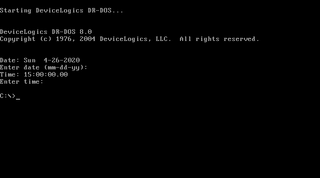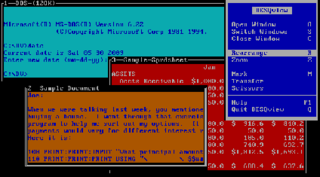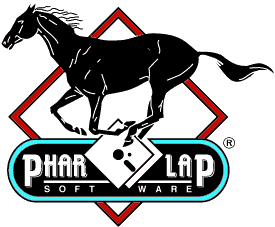
DR-DOS is a disk operating system for IBM PC compatibles. Upon its introduction in 1988, it was the first DOS attempting to be compatible with IBM PC DOS and MS-DOS.
A terminate-and-stay-resident program is a computer program running under DOS that uses a system call to return control to DOS as though it has finished, but remains in computer memory so it can be reactivated later. This technique partially overcame DOS's limitation of executing only one program, or task, at a time. TSRs are used only in DOS, not in Windows.
Real mode, also called real address mode, is an operating mode of all x86-compatible CPUs. The mode gets its name from the fact that addresses in real mode always correspond to real locations in memory. Real mode is characterized by a 20-bit segmented memory address space and unlimited direct software access to all addressable memory, I/O addresses and peripheral hardware. Real mode provides no support for memory protection, multitasking, or code privilege levels.

DESQview (DV) is a text mode multitasking operating environment developed by Quarterdeck Office Systems which enjoyed modest popularity in the late 1980s and early 1990s. Running on top of DOS, it allows users to run multiple programs concurrently in multiple windows.

In IBM PC compatible computing, DOS memory management refers to software and techniques employed to give applications access to more than 640 kibibytes (KiB) of "conventional memory". The 640 KiB limit was specific to the IBM PC and close compatibles; other machines running MS-DOS had different limits, for example the Apricot PC could have up to 768 KiB and the Sirius Victor 9000, 896 KiB. Memory management on the IBM family was made complex by the need to maintain backward compatibility to the original PC design and real-mode DOS, while allowing computer users to take advantage of large amounts of low-cost memory and new generations of processors. Since DOS has given way to Microsoft Windows and other 32-bit operating systems not restricted by the original arbitrary 640 KiB limit of the IBM PC, managing the memory of a personal computer no longer requires the user to manually manipulate internal settings and parameters of the system.
In computing, the DOS Protected Mode Interface (DPMI) is a specification introduced in 1989 which allows a DOS program to run in protected mode, giving access to many features of the new PC processors of the time not available in real mode. It was initially developed by Microsoft for Windows 3.0, although Microsoft later turned control of the specification over to an industry committee with open membership. Almost all modern DOS extenders are based on DPMI and allow DOS programs to address all memory available in the PC and to run in protected mode.

In DOS memory management, extended memory refers to memory above the first megabyte (220 bytes) of address space in an IBM PC or compatible with an 80286 or later processor. The term is mainly used under the DOS and Windows operating systems. DOS programs, running in real mode or virtual x86 mode, cannot directly access this memory, but are able to do so through an application programming interface called the Extended Memory Specification (XMS). This API is implemented by a driver (such as HIMEM.SYS) or the operating system, which takes care of memory management and copying memory between conventional and extended memory, by temporarily switching the processor into protected mode. In this context, the term "extended memory" may refer to either the whole of the extended memory or only the portion available through this API.

In DOS memory management, expanded memory is a system of bank switching that provided additional memory to DOS programs beyond the limit of conventional memory (640 KiB).

In DOS memory management, conventional memory, also called base memory, is the first 640 kilobytes of the memory on IBM PC or compatible systems. It is the read-write memory directly addressable by the processor for use by the operating system and application programs. As memory prices rapidly declined, this design decision became a limitation in the use of large memory capacities until the introduction of operating systems and processors that made it irrelevant.

Quarterdeck Office Systems, later Quarterdeck Corporation, was an American computer software company. It was founded by Therese Myers and Gary Pope in 1981 and incorporated in 1982. Their offices were initially located at 150 Pico Boulevard in Santa Monica, California and later at 13160 Mindanao Way in Marina del Rey, California, as well as a sales and technical support unit located in Clearwater, Florida. In the 1990s, they had a European office in Dublin, Ireland. Their most famous products were the Quarterdeck Expanded Memory Manager, DESQview, CleanSweep, DESQview/X, Quarterdeck Mosaic, Manifest and Partition-It.
CEMM, for Compaq Expanded Memory Manager was the first so-called PC "memory manager" for Intel 80386 CPUs, able to provide expanded memory (EMS) emulation by using the virtual memory features and the virtual 8086 mode of the CPU.
A DOS extender is a computer software program running under DOS that enables software to run in a protected mode environment even though the host operating system is only capable of operating in real mode.

Phar Lap Software, Inc., was a software company specializing in software development tools for DOS operating systems. The company was named after the champion New Zealand racehorse Phar Lap. They were most noted for their software allowing developers to access memory beyond the 640 KiB limit of DOS and were an author of the VCPI standard.
EMM386 is the expanded memory manager of Microsoft's MS-DOS, IBM's PC DOS, Digital Research's DR-DOS, and Datalight's ROM-DOS which is used to create expanded memory using extended memory on Intel 80386 CPUs. There also is an EMM386.EXE available in FreeDOS.

In DOS memory management, the upper memory area (UMA) is the memory between the addresses of 640 KB and 1024 KB (0xA0000–0xFFFFF) in an IBM PC or compatible. IBM reserved the uppermost 384 KB of the 8088 CPU's 1024 KB address space for BIOS ROM, Video BIOS, Option ROMs, video RAM, RAM on peripherals, memory-mapped I/O, and obsoleted ROM BASIC.
HIMEM.SYS is a DOS device driver which allows DOS programs to store data in extended memory according to the Extended Memory Specification (XMS). The memory beyond the first 1 MB of address space is required by Windows 9x/Me in order to load; therefore, these versions of Microsoft Windows require HIMEM.SYS to be loaded to be able to run.
In computing, the Virtual Control Program Interface (VCPI) is a specification published in 1989 by Phar Lap Software that allows a DOS program to run in protected mode, granting access to many features of the processor not available in real mode. It was supplanted by DOS Protected Mode Interface (DPMI) shortly after being introduced, due in large part to VCPI's inability to work in Windows 3.0's protected mode.

DOS is a family of disk-based operating systems for IBM PC compatible computers. The DOS family primarily consists of Microsoft's MS-DOS and a rebranded version, IBM PC DOS, both of which were introduced in 1981. Later compatible systems from other manufacturers include DR-DOS (1988), ROM-DOS (1989), PTS-DOS (1993), and FreeDOS (1998). MS-DOS dominated the IBM PC compatible market between 1981 and 1995.
The maximum random access memory (RAM) installed in any computer system is limited by hardware, software and economic factors. The hardware may have a limited number of address bus bits, limited by the processor package or design of the system. Some of the address space may be shared between RAM, peripherals, and read-only memory. In the case of a microcontroller with no external RAM, the size of the RAM array is limited by the size of the integrated circuit die. In a packaged system, only enough RAM may be provided for the system's required functions, with no provision for addition of memory after manufacture.
DOS Protected Mode Services (DPMS) is a set of extended DOS memory management services to allow DPMS-enabled DOS drivers to load and execute in extended memory and protected mode.







